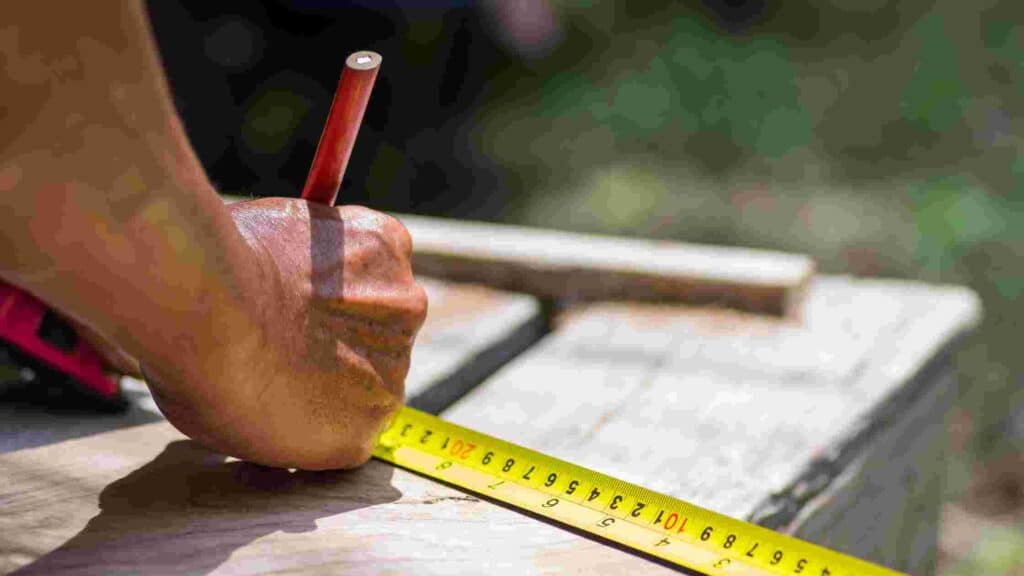Are you considering a major makeover for your backyard? Perhaps you’re planning to install a lush carpet of sod to transform your outdoor space. If so, it’s essential to know how to measure a backyard accurately.
Fortunately, this task may sound daunting, but it’s not as challenging as it seems. While it does involve a bit of mathematics, it’s no more complex than basic algebra. In this guide, we’ll walk you through the process step by step.
Simple Yards: How To Measure A Backyard
The method we’ll describe below involves taking measurements and completing the equation. It eliminates the guesswork from the question of how to measure a backyard.
Simple yards typically consist of square or rectangular spaces, making these calculations a breeze. This efficient approach puts you on the fast track to completing your yard project.
Step 1: Taking Measurements

The first thing you need to do is measure the individual lengths of each segment of your backyard. To accomplish this, you’ll need to physically measure the edges of your yard borders.
This method works best for simple yards that are rectangular, square or have well-defined, non-sloping lines. Once you’ve gathered these measurements, you can move on to the equation part of the process.
Taking measurements of your yard can serve various purposes. Besides helping you determine the right amount of sod for your lawn, it can assist you in planning other additions, like a serene koi pond.
Step 2: The Calculation
The initial equation might sound intimidating, but it’s quite straightforward. To begin, assign each measurement a letter, such as A, B, C, and so on. This helps you keep track of each value accurately.
Next, multiply A by B and C by D, considering you should have approximately 4 to 6 different measurements, based on your yard’s complexity.
It’s worth noting that this method is most effective for simple rectangular and square yards.
Now, add up all these totals. The resulting number is squared because it originates from the 2 measurements you started with. Most often, people express this measurement in square meters, making it easy to comprehend.
While this equation simplifies the process of determining your yard’s size, it can also assist you in various other calculations.
This includes identifying areas where you might have standing water—a concern that can lead to significant yard damage if left unaddressed (here’s how to soak up excess water in yard).
Tackling Complex Yards: A Detailed Approach
Complex yards, while presenting more challenges, still have a practical solution for accurate measurement. Although this method involves a bit more guesswork than algebra, it’s effective when done right.
Step 1: Multiple Measurements And Graph Paper
To measure a complex yard, start by taking various measurements at different points within your outdoor space.
Then, grab a sheet of graph paper and sketch out your garden to scale using these measurements. This will give you an approximate outline of the size and shape of your yard.
Step 2: Estimating Your Yard’s Size
Now, examine the sketch to identify the twists in your yard.
You can estimate the yard’s size by counting the blocks on the graph paper and determining how many are partially filled. This approach involves some guesswork and multiple measurements, but it can yield an accurate result.
Remember, the more you measure, the better your estimate will be.
If you ever doubt the accuracy of your measurements, it’s a good practice to round up slightly, around 5 percent, to ensure you have enough material to cover your yard adequately.
Looking For Different Measurements?

If you initially measured in yards or feet but need the measurement in meters, there’s no need to worry.
You can easily convert measurements from one unit to another using your own knowledge or by referring to online conversion tools.
Just search for the conversion you need, such as meters to feet, and you’ll find plenty of resources to assist you.
Conversions like these aren’t complicated, but if you’re unsure about your calculations, don’t hesitate to seek guidance from a landscaping expert.
Starting Your Project
With the correct measurement in hand, you’re now ready to embark on your backyard project.
Whether you’re laying sod, planning a landscaping makeover, or tackling any other outdoor endeavor, having an accurate measurement is crucial (be sure to check out our top pick for the best artificial grass).
Having Trouble Figuring It Out?
If you’re struggling with the calculations or simply find math challenging, don’t worry. There are user-friendly turf generators available to help you determine your yard’s measurements.
These generators eliminate the need for manual calculations.
You input the measurements, and the tool does the math for you, providing an accurate measurement in square feet. This simplifies the process and gets you started on your backyard project quickly.
Consulting A Professional
If all else fails or you have doubts about the accuracy of your measurements, consider consulting a landscaper.
These experts possess the experience and knowledge to provide you with a precise measurement of your backyard without any hassle.
FAQs – How To Measure Backyard
1. Can I measure my yard with Google Maps?
Yes, you can estimate yard measurements using Google Maps, but it may not be highly accurate.
2. How do you measure an irregular backyard?
To measure an irregular backyard, break it into smaller shapes (like triangles or rectangles) and calculate each area separately.
3. What tool is used to measure a yard?
A tape measure or a long measuring wheel is commonly used to measure a yard accurately.
4. How to measure a yard by walking?
To measure a yard by walking, use a measuring wheel or count your steps and convert them into feet or meters.
5. How to measure a yard with your feet?
You can estimate yard measurements with your feet by counting steps and multiplying them by your average step length.
Final Thoughts: How To Measure Yard Size
Measuring your backyard doesn’t have to be a daunting task.
You can choose to follow the step-by-step equation method or opt for the convenience of a turf generator (check out the turf calculator). Whichever route you take, rest assured that you can measure your backyard with minimal effort.
You don’t need to hire someone or stress over unnecessary problems. Once you have the measurement, you’re ready to dive into your backyard project, whether it’s gardening, landscaping, or any other exciting endeavor.
Understanding how to measure a backyard is the first and crucial step toward your outdoor transformation.
